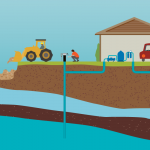By Edgar Camero, Tina Ansong & Gregory Miao
Safe and habitable housing and access to clean water are basic human rights. Studies have confirmed that housing quality and water access are foundational to health. But residents in rural communities sometimes face significant challenges in accessing clean water.
Water Access Challenges in Rural Areas
Rural households can face a wide range of water infrastructure challenges. Imagine needing to travel 40 miles to get water for drinking, cooking, and bathing; experiencing sewage backup into your toilet, sink, or bathtub; or drinking, washing your hands, or showering in water contaminated with toxins like arsenic. Rural households and communities are disproportionately affected by poor or substandard water infrastructure and accompanying challenges, which in turn affect housing conditions and health outcomes, contributing to greater incidence of acute and chronic illnesses among residents in rural communities.
The prevalence of these challenges is increasing for rural communities due to rising water costs, aging infrastructure, depleted water supplies, climate change, and regulatory failures. For example, rural households disproportionately face water shutoffs due to an inability to pay. From 2010 to 2020, rural communities faced a 41% increase in water and sewer utility rates, compared with a 27% increase in suburban areas. In 2019, a town in Kansas with an aging water infrastructure and a population of 650 completed a water treatment system that cost $2.4 million — an expensive investment for a community of that size. Additionally, rural communities must navigate regulatory failures that constitute a structural disadvantage. For example, the Safe Drinking Water Act — which regulates the nation’s public drinking water supply, safeguarding drinking water for most US residents — does not apply to private wells, which are the primary source of drinking water for more than 43 million residents.
Improving Rural Water Systems
Rural communities should not be penalized by water access issues stemming from harmful policymaking that has resulted in regulatory and funding inequities. Instead, legislation should be written to include regulatory actions that better serve small and rural communities. For rural communities, access to capital is important because 98% of public investment in US water and sewer infrastructure comes from local government revenues. Some rural communities are unable to collect sufficient revenue to maintain or upgrade aging water systems because of population decline or local economic conditions. Funding inequities should be addressed by specifically allocating funding opportunities to rural communities. More inclusive legislation and targeted funding streams can help address systemic drivers of inequity (like structural racism and inequitable economic development) that contribute to water issues in the rural United States.
Policy can also be an effective tool for improving the safety of federally unregulated water sources. A policy to increase water access can take many forms. Some policies can increase public water access for rural households by expanding on the federal definition of water or water systems at the state level. Other policies can prioritize or dedicate funding for water infrastructure projects where water access issues are most prevalent. No one approach to policies or actions will fit all rural communities. A well-designed policy would be created in partnership with community members who will be most affected by the policy change.
The following policies reflect actions that state governments have taken to develop database tools for tracking water quality; to add public water system classifications; and to engage with communities to ensure equitable water access for all.
- New Mexico’s Department of Health (DOH) has set out to build a statewide database that enables the department to evaluate contamination risks for private wells, which provide drinking water for 20% of New Mexicans. Now the DOH can more accurately and efficiently assess testing results for private wells.
- The state of Washington aimed to improve water quality by adding a separate classification — Group B public water system — which is primarily defined as a water system “that provides drinking water to fewer than fifteen service connections and fewer than twenty-five people per day.”
- California passed Senate Bill 200 (SB 200), which established the Safe and Affordable Drinking Water Fund. The goal is to fund water infrastructure projects that provide equitable access to water. SB 200 includes dedicated funding streams to support projects in "disadvantaged communities."
To learn about other policy solutions to address water challenges, access our guide.
Opportunities to Create Positive Change
Here are two opportunities to address water access issues in rural communities:
The first opportunity is increasing community participation in local water board elections. Water boards decide whether and how residents get clean, safe, and affordable water. Water boards also determine how and where public funds are spent. Water board elections can result in new leadership and perspectives that help shape the future. One issue, however, is that seats on water boards often go uncontested. In 2019, the Omochumne-Hartnell Water District, located near Sacramento, held an election for board members 43 years after its last election. In fact, 87% of local water boards in the southern San Joaquin Valley did not hold a single election from 2014 to 2018. Therefore, encouraging community members to run for water board seats (and then supporting them) might be a promising step toward solving water access issues in rural communities.
The second opportunity is increasing access to capital by providing sustainable and direct funding to rural communities. One recent success was the 2021 Infrastructure Investment and Jobs Act's $55 billion in water infrastructure funding, including funds for "small and disadvantaged communities" that can be directed to rural communities. By dedicating funding to rural communities, the infrastructure bill will help mitigate the financial impacts of declining local revenues in rural communities. The bill authorized new programs and increased funding for existing opportunities such as on-site technical assistance programs and state revolving funds. Although the infrastructure bill is a short-term investment, it is a step in the right direction. As policymakers continue to propose and design solutions to improve water access in rural communities, equity and sustainability should be considered throughout all stages of planning and implementation.
This blog post is the first in our Toward Better Rural Futures series, which highlights the unique assets of rural communities as well as the challenges they face. Access our collection of resources for rural policymaking to read the other installments in the series.
This blog series is part of the Toward Better Rural Futures project, which participates in the Aspen Institute’s Thrive Rural Initiative and is funded by the Robert Wood Johnson Foundation. Toward Better Rural Futures aims to foster greater collaboration and alignment across local, regional, and state levels of government, equipping leaders with the tools and knowledge to fundamentally shift power, opportunity, and resources in order to create healthy rural places where everyone can thrive.
3/8/2023

